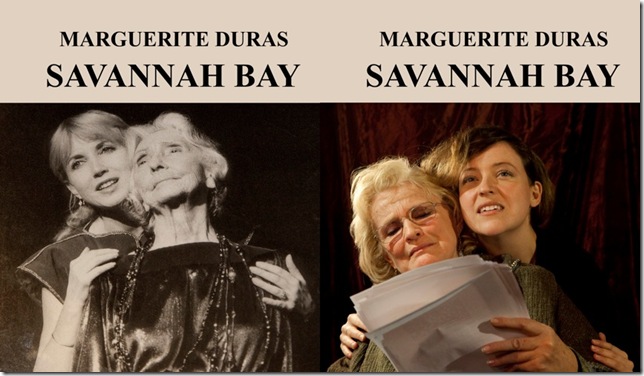Savannah Bay: Marguerite Duras at the American Repertory Theatre
PHOTO.Lionel Patrick Kerman.
l.Bulle Ogier et Madeleine Renaud
R.Marie Christine Barrault, Guila Klara Kessous
Marguerite Duras’ Savannah Bay was performed at Cambridge’s Loeb Drama Center (home of the American Repertory Theatre) on February 21 in honor of the centennial of Jean-Louis Barrault’s birth. In the cast were the well-known French stage and screen actress Marie-Christine Barrault and her young disciple Guila Clara Kessous. Mme Barrault is the niece of actor-director Jean-Louis Barrault and his wife, actress Madeleine Renaud. During their lifetimes, Barrault and Renaud reached the pinnacle of theatrical success in France, forming their own company in 1946. As artistic director, and for many years leading actor, Barrault not only drew from a broad repertory of classics – French and otherwise – but introduced new and experimental works, many of which gained renown. The company’s tours brought the best of French culture to the wider world.
In 1983, aged eighty-three, Madeleine Renaud triumphed in Savannah Bay (with Bulle Ogier) written especially for her by Duras, who also directed it. French productions being rare in the Boston area, Francophones and theatre lovers were excited by the prospect of Savannah Bay. Unfortunately, poor pre-show publicity gave a false impression of what was to come. Only when the play began did the audience realize that the promised subtitles were non-existent and the performance itself was a partially staged reading rather than a production.
Nonetheless, for French speakers, it was a rewarding evening. The play’s language, beautifully simple, is poetic and mesmerizing to the ear. Duras makes use of rhythm, repetition, and contradiction to recapture events that may or may not have occurred.
Two women, one old, one young, engage in dialogue. The elder is known as Madeleine, the younger is unidentified, until she names herself Savannah near the play’s end.
Time and place are obscure.
Savannah Bay opens with Edith Piaf’s recording of “Les mots d’amour,” fragments of which are repeated throughout. This popular song, ambiguous in its own way, serves as the play’s motif. It sings of undying love, betrayal, forgetfulness, and the power of words as the singer moves from relationship to relationship. The characters change, the words remain.
And it is words that the Young Woman wants from Madeleine. She demands, cajoles, and urges Madeleine to recount a story of love, birth, disappearance, and possibly death. The audience is never sure of her relationship to the confused old woman. She could be Madeleine’s daughter, granddaughter, or Madeleine herself in an early incarnation.
A famous theatre actress in her time, who memorized countless texts, Madeleine stumbles haltingly and painfully through her own story – if it is her own. In this meta-play, life and theatre intermingle. There are two events: a boy and girl meet on a white rock in the sea and fall passionately in love. She bears a child one night, abandons it, and disappears into the sea. As the play continues, the narrative and dialogue are shared by both women who address the audience as if performing for them.
Although Marie-Christine Barrault is far younger than Renaud was in 1983, she is a convincing Madeleine, one who speaks her lines beautifully in the plummy voice of the kind of august, but outdated actress she is playing. We see Madeleine’s weakness, her stubbornness, her fear, and losses. At the same time, Barrault layers the characterization by drawing on Madeleine’s acting persona, adding a certain melodramatic quality to the portrayal.
Guila Clara Kessous’ performance as the Young Woman, while truthful, lacks variety. Part of the problem is that the role is underdeveloped. The character comes close to being a device to motivate Madeleine to speak. Both actresses have the strong emotional connection necessary for the play. At times, they were very moving.
As of now, the show seems in rehearsal stage. In Paris, the actresses were aided by the director Jean-Pierre Bernard who likely supplied the basic blocking. In Cambridge, the Loeb stage was disadvantageous, its atmosphere cold. They played on a bleak set that was being used for a modern version of Sophocles’ Ajax, disconcerting to say the least. Lighting was rudimentary. Props consisted of two black plastic chairs and a coat rack with a few articles of clothing and several necklaces. Strangely, both actresses were miked. The costumes were vaguely suggestive of age and character, but obviously not created for the play. Perhaps Kessous’ black form-fitting dress and very high-heeled shoes were meant to evoke the eroticism of the young girl’s love. Barrault was clothed in a loosely fitted blue velvet dress that fell to her ankles – an indication maybe of another era.
A reading cannot be judged as a full-fledged performance. It would be interesting to see Marie Christine Barrault and Guila Clara Kessous bring the work to the next phase.
Savannah Bay
Written by Marguerite Duras
At the Loeb Drama Center, Cambridge, Massachusetts
Cast
Madeleine – Marie-Christine Barrault
Young Woman – Guila Clara Kessous
